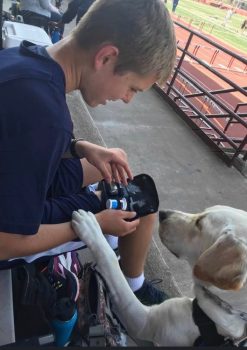
With the support of his alert dog Morris, the latest insulin pump technology and his care team, Cameron is thriving and hopes to be a role model for other kids with diabetes. He shares his experience in time for National Diabetes Month.
Wherever 14-year-old Cameron Hendry goes – school, soccer practice, wakeboarding, shopping, even a trip to Hawaii – a Labrador retriever named Morris follows.
Morris is not only the high school freshman’s beloved pet. He is Cameron’s diabetes alert dog, always there on his left side to monitor his blood sugar and let him know when his level is too high or low.
Seven years ago, Cameron was diagnosed with type 1 diabetes, an autoimmune disease in which blood sugar levels rise because the body stops making insulin. The chronic condition requires lifelong insulin via shots or an insulin pump.
Symptoms of type 1 diabetes include increased thirst, urination and weight loss. Fortunately, Cameron’s parents recognized his symptoms early and took him to Seattle Children’s emergency department. Cameron was diagnosed and his family received intensive education on how to manage his condition, which included checking blood glucose levels and giving insulin shots multiple times each day. There is currently no cure, though promising research is underway.
“Type 1 diabetes is quite a burden day to day on both kids and their parents,” said Erin Sundberg, ARNP, a pediatric nurse practitioner with Seattle Children’s Endocrinology and Diabetes team, who has been seeing Cameron for the past two years. “It requires round-the-clock vigilance because glucose levels can change due to activity and illness, so patients need to check their blood sugar multiple times each day.”
Cameron and his family remember the challenges of his early days with diabetes. He struggled with taking insulin shots and he and his parents would wake up multiple times at night to check his blood sugar. Now, Cameron uses both an insulin pump and a continuous glucose monitor to manage his diabetes.
Even in the challenging early days, Cameron has never let his condition stop him from doing what he loves, including playing soccer.
A helping paw

In 2017, at a Seattle Children’s event, Cameron was introduced to his hero, Jordan Morris, a forward on the Seattle Sounders who also has type 1 diabetes and offers support and inspiration for kids living with the condition.
“The fact that Jordan Morris had diabetes while playing professional soccer and being on the national team was a huge inspiration for Cameron,” said Jamie Hendry, Cameron’s mother.
Last year, while at a special Sounders game that featured kids with diabetes like Cameron, the Hendrys met a family whose child had a diabetic alert dog that could recognize their blood sugar levels through sniffing. They were immediately interested in getting one for Cameron and found a dog through Diabetic Alert Dogs of America.
By December 2018, Cameron had a trained, certified alert dog, who he named Morris.
“I love soccer and Jordan Morris has diabetes too, so I just thought it was a perfect name,” Cameron said.
Hendry saw an immediate connection between Morris and Cameron.
“When we picked up Morris, he went right to Cameron and was alerting within 10 minutes of meeting him,” Hendry said. “It was amazing.”
Morris puts his paw on Cameron’s knee to alert him, until Cameron corrects his blood sugar. At night, Morris wakes up Cameron if he senses that his levels are high or low. Morris even alerts Cameron while napping and playing. After he helps Cameron, the family showers Morris in treats, praise and affection as a reward.
Night and day

Almost one year later, Morris has become part of the family. He has also improved Cameron’s quality of life.
“I love Morris. He’s such a good dog and has made me feel a lot better,” Cameron said. “He keeps my blood sugar stable because he alerts me before my insulin pump even does. My numbers are also better at night because of all that he does during the day.”
After getting Morris, Cameron feels more energetic, sleeps better and thinks more clearly. Morris can even alert Cameron from across the soccer field.
“It’s been night and day,” Hendry said. “Morris being able to alert Cameron before his technology or before he could feel it made him a different kid. He used to just try to make it through soccer practice. Now, he has energy for both practice and goofing off with his friends after.”
Cameron recently started high school, where he is on the soccer team and plays trumpet in jazz band and pep band. Morris’s presence made it easier for Cameron to meet new people while starting high school.
“You watch Cameron and Morris get out of the car, and everyone smiles, because the dog is so cute,” Hendry said. “Their day is brightened because of them.”
Sundberg has seen how Morris benefits Cameron while also raising awareness of diabetes.
“Morris is such a well-behaved dog, and you can tell by just talking to them how much joy he brings their family,” Sundberg says. “The coolest thing is that all the kids at his school know about diabetes now, because the dog is a local celebrity. That’s really neat from an awareness and advocacy standpoint.”
“They’re best friends,” Hendry said. “One time, Morris hurt his paw, so he had to miss school for a few days. Both Morris and Cameron moped. They don’t like to be apart.”
An integrated system

In addition to having an alert dog, Cameron is using innovative diabetes technology: an insulin pump integrated with a continuous glucose monitor. The Medtronic 670G system, which Cameron uses, suspends insulin delivery when glucose levels are predicted to reach a low limit. It also increases insulin delivery when blood sugar is going up.
Sundberg says the system can reduce the daily burden of diabetes management, especially in the overnight time period.
“With his pump, glucose level monitoring and insulin delivery ‘talk’ to each other,” Sundberg said. “Cameron can go about his day while the pump monitors him and makes decisions about whether he needs more insulin or less. This technology is the future of diabetes management and holds so much promise for reducing the daily burden of diabetes for our patients and their families.”
The continuous glucose monitor gives real-time glucose readings and alerts to impending high or low blood glucose levels.
“The pump has been a game changer,” Cameron said. “It keeps my numbers in tighter range and has made such a big difference because if my blood sugar is getting high, it automatically puts insulin in to bring it down.”
Cameron has appointments with Sundberg every four months to check in.
“Erin is phenomenal,” Hendry said. “She remembers all of the little details about Cameron, like how he loves soccer. She cares, which is just amazing.”
A desire to help others

Cameron hopes to be a source of encouragement for younger kids with type 1 diabetes. His message for kids who are newly diagnosed is that they can live full, happy lives with diabetes.
“It may be hard to get used to in the beginning, but long term it’s not as bad as some people think,” Cameron said. “It doesn’t really get in the way. If you have low blood sugar, you might have to take some time off from an activity, but that’s not too bad. Having diabetes doesn’t slow me down at all. I still do everything I would do if I didn’t have type 1 diabetes.”
Cameron is open to sharing his experiences with others.
“We need to find a way for Cameron and Morris to meet other patients and boost their spirits,” Hendry said. “Older kids with diabetes like Cameron would love to help the little ones.”
Sundberg notes that although diabetes can be particularly challenging to manage during the teen years due to physiologic factors and developmental changes, Cameron is doing great and stands out because of his optimistic attitude.
“Cameron naming his dog after Jordan Morris and wanting to inspire other kids just shows the domino effect of positive role models,” Sundberg said. “He exemplifies not letting diabetes prevent him from achieving goals and doing what he loves. It doesn’t mean that his diabetes has been easier to manage, but he is resilient and works with his family to navigate the challenges. He’s going to accomplish great things and diabetes is going to be a side note, not the focus, of his life.”

